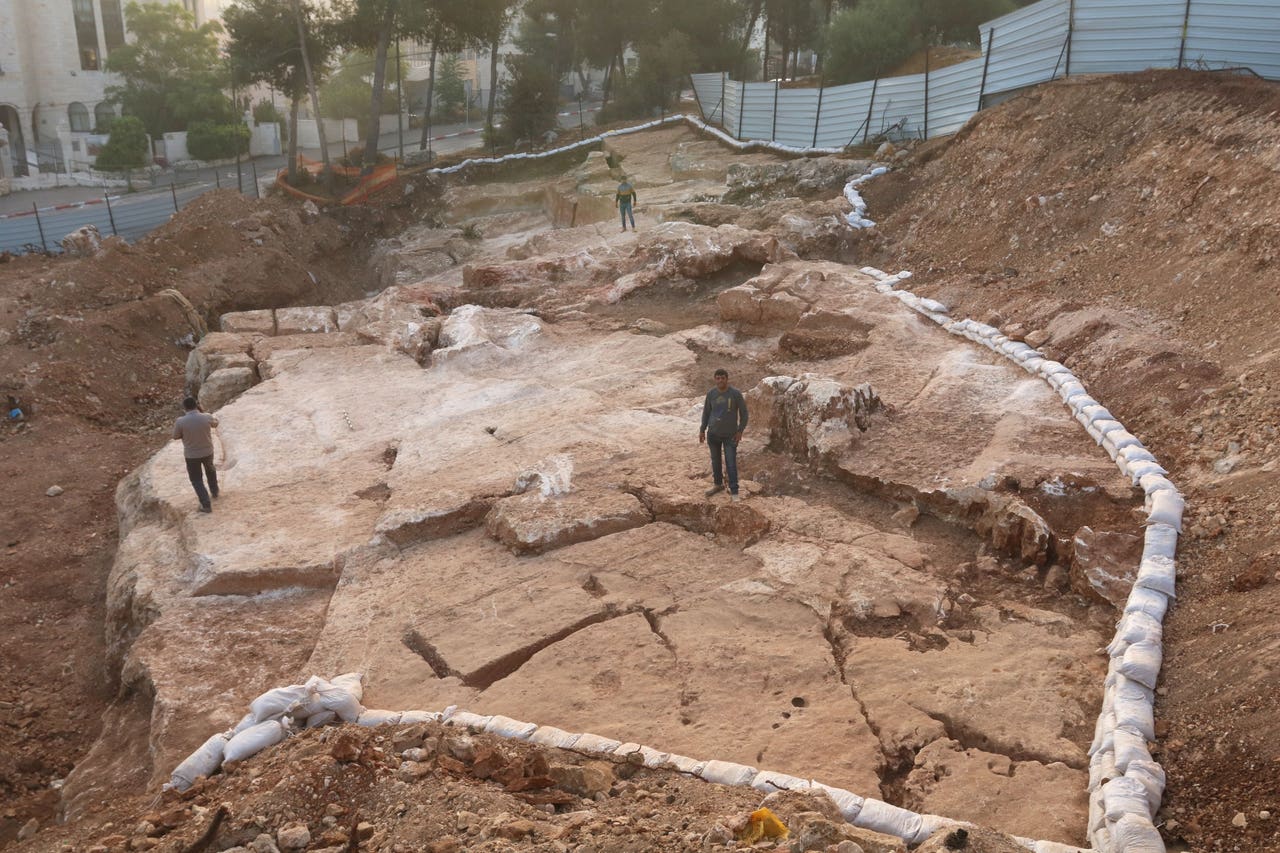Summary: Israeli archaeologists excavating in Jerusalem find remains of a 2,000-year-old quarry, revealing ancient stone preparation techniques from the biblical Second Temple period.
“As he [Jesus] came out of the temple, one of his disciples said to him, “Look, Teacher, what wonderful stones and what wonderful buildings!” – Mark 13:1 (ESV)
Quarrymen’s Hill
Archaeologists have been given a rare opportunity to study and recreate the techniques employed to carve out the giant stones used for building the Second Jewish Temple and other fortresses and palaces of Herod the Great.
The unearthed portion of the vast limestone quarry covers around 6,500 sq ft (600 sq m) but is only part of the entire site, which is suspected to be up to three times larger. The quarry was recently discovered in the northwest Jerusalem neighborhood of Har Hotzvim, during a salvage excavation by IAA archeologists before construction of a parking lot began. The bustling area of Har Hotzvim which translates as ‘Quarryman’s Hill’ is one of Israel’s busy high-tech industrial centers and home to international companies such as Intel, Teva, Cisco and Mobileye.
The quarry site has been dated to the first century BC and was still active in the following century while Herod’s expansion of the Temple was being finished, according to the Israel Antiquities Authority (IAA).

Massive Stones Uncovered
“The large-scale building projects in ancient Jerusalem, such as the Temple Mount, required a vast amount of building materials and the ability to organize and coordinate the quarrying and transportation of thousands of building blocks to the ancient city,” said Dr. Moran Hagbi, the excavation director at IAA.
“Building blocks in various stages of working were discovered in the quarry. For example, we uncovered large, square blocks of stone about to be detached from the bedrock, prior to loading and transporting them to the ancient city.” Massive stones extracted from the area measure 5 ft x 6.6 ft (1.5m x 2m).

It is the giant size of the blocks that has allowed IAA experts to date the quarry. The Second Temple period was the only time in Jerusalem’s long history that such large stones were used for the multiple major building projects of King Herod.
Click below for a short video from TBN on the largest foundation stone found at the Western Wall. While Patterns of Evidence does not necessarily endorse every view of outside sources, we think the content of this video is fascinating.
King Herod I, The Builder
King Herod ruled the Roman province of Judea on behalf of the Roman Empire from about 36 BC to 4 BC. Herod was the family name of the ruling dynasty. There are four different Herods mentioned in the New Testament, a helpful thing to be aware of, so as not to confuse one with the other.
Herod I, who came to be known as Herod the Great, was the king who slaughtered all boys two years old and younger in Bethlehem, attempting to kill a potential rival (Matt. 2). Herod was afraid of what he had heard from the traveling magi who had stopped in Jerusalem as they searched for the newborn “King of the Jews.” They were directed to Bethlehem after Herod’s scribes determined that the Messiah had been prophesied to be born there.
This Herod is also the one known for colossal building projects such as the rebuilding and expansion of the Second Temple and its foundation refortification, referred to as the Temple Mount. Herod raised an enclosure around the Cave of the Patriarchs in Hebron, created whole new cities, including Caesarea Maritima along the Mediterranean coast, and built amazing fortresses and palaces at Masada and Herodium. He also rebuilt the mountaintop fortress Machaerus where John the Baptist was later beheaded. A steady supply of huge and heavy stones were needed from quarries, such as Har Hotzvim, to accomplish all this construction.

Ancient Discovery offers “Golden Opportunity” to Learn
“For us, this quarry presents a golden opportunity: because some of the stones were left in situ, in this way, we can copy ancient technologies and experiment with them in order to recreate the processes by which the building stones were quarried,” continued Dr. Moran Hagbi.
By using copies of ancient tools found in previous excavations and following the clear demonstration given by the site of quarry and stone preparation phases, IAA archeologists plan to test the effectiveness of methods described in ancient sources for detaching stone blocks.

Conclusion
This rescue dig protected the ancient quarry from destruction because of new building projects rising up in the fast growing neighborhood of Har Hotzvim. “In a symbolic way, Jerusalem’s current development boom presents us with an opportunity to excavate and research the great building projects in Jerusalem in antiquity,” said Dr. Eli Eskozido, general director of the IAA.
“Before any development project begins in Jerusalem, our archaeologists are called upon to excavate and examine any ancient finds, for the sake of future generations.”
Building ventures of the future are shining a spotlight on the projects from the past. Thankfully, this ‘soon to be’ parking lot wasn’t paved before Quarryman’s Hill and its enormous building stones could be excavated and studied.
TOP PHOTO: A 2,000-year-old stone quarry discovered in the Jerusalem neighborhood of Har Hotzvim. (credit: Shai Halevi, IAA)



